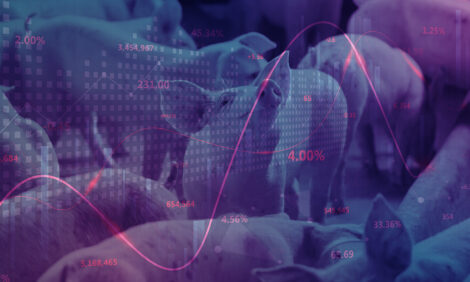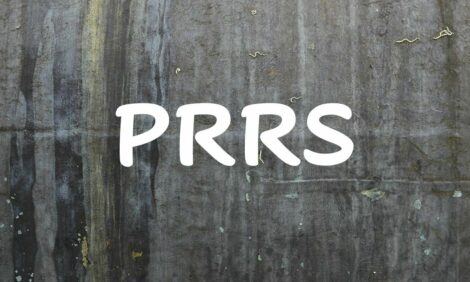



Quantifying Pig Carcase Quality
By Dr. Mark Hawe, College of Agriculture, Food and Rural Enterprise (CAFRE) and Erica Chisholm, Agri-Food & Biosciences Institute (AFBI)Producers and processors share the common goal - improving carcase quality.
Current situation
 |
| "Reviewing the PiGIS program on-line: (left to right) Mark Hawe (CAFRE), Mark Browne (AFBI) Hugh McReynolds (Managing Director Grampian Country Pork Ltd. Cookstown) Robert Overend (Deerpark Pedigree Pigs) and Erica Chisholm (AFBI)" |
In Northern Ireland, as elsewhere, producers currently receive individual carcase details including weight, P2 fat measurement and any condemnations from the processing plant. There is also a basic summary showing averages for these measurements. This information is useful, but limited with no easy way to compare either changes in carcase quality over time, or individuals against the "best" producers.
The Pig Grading Information System (PiGIS), jointly developed in Northern Ireland by CAFRE and AFBI, was recently launched by the Minister of Agriculture, Michelle Gildernew. She says that its development is a significant benefit to the local pig industry and will allow clear market information to be provided by the processor as to the quality of carcasses required.
"It will enable pig producers to make the necessary management adjustments to meet market demands. Both producers and processors now have a tool to help them improve the quality of Northern Ireland pig carcasses and so the performance of the pig sector in the market place," she said.
The PiGIS computer programme is tailor-made to assist both producers and processors assess and benchmark carcase quality and quantify improvements achieved. The programme is easy to use, totally flexible and provides analysis which is self explanatory.
A key feature is that kill data relating to weight, grade and condemnations is directly uploaded from every pig processing plants in Northern Ireland to a central benchmarking database. This information can be accessed by registered producers via the internet at www.ruralni.gov.uk/pigis. Each producer has an individual identity and password, that allows them access to data from their home computer on a "real time" basis.
PiGIS reports
Through PiGIS, producers can assess the quality of the carcasses they supply over any time period. Figure 1 shows a typical report, illustrating the range in probe measurements over a specified time period involving, in this case, 1256 pig carcasses.Figure 1 Grading profile

|
Summary Information
|
|
| Number Of Pigs | 1256 |
|---|---|
| Rank | - |
| Code 1 | 98.0% |
| Code 2 | 2.0% |
| Average Probe | 9.7mm |
| Probe Variability | 1.89 |
| Condemned¹ | 1.0% |
The percentage of pigs in each fat probe category is shown as a bar-graph. More detailed information is provided in the accompanying table including average probe measurements, variation in probe depths and the percentage of pigs in each grade. Similar information can be obtained for carcase weight.
On-farm changes which influence grading, weight and so financial returns can also be identified using PiGIS. For example, the effect of changes in genetics, nutrition and slaughter weight can be easily and quickly quantified using the programme to compare carcasses from one period against those from another. From this, the optimum slaughter weight can be identified.
The "Golden Box"
The "Golden Box" facility quantifies the number of carcasses within more stringent specifications. As contracts provide bonus payments for pigs within "tighter" weight and grade ranges, producers can immediately quantify the proportion of their carcasses which will receive these payments.
A typical report is shown in Figure 2, where 35 per cent of pigs are in the Golden Box range from 65kg to 80kg with probe measurements of 14 mm or less. The benefits of farm changes can be determined by the effect on the proportion of Golden Box pigs.

|
Summary Information
|
|
| % Of Pigs In Golden Box¹ | 35.17% (5617 pigs) |
Compare with the "rest or the best"
By using PiGIS' powerful benchmarking facility producers, can now compare or benchmark the quality of their carcasses with "the rest or the best" in the industry over any time period. With this unique option producers can easily compare the weight, grade or proportion of "Golden Box" pigs with any proportion of the top producers in the industry. For example the grade of pigs supplied over any time period chosen can be compared with the industry as a whole or against the top five per cent, 10 per cent or 20 cent of producers etc. A typical benchmarking report is shown in Figure 3.
Figure 3 Producers grading compared with the top 5% of the industry
|
Summary Information
|
||
| Number Of Pigs | 2375 | 3456 |
|---|---|---|
| Rank | 26-50% | - |
| Code 1 | 41.3% | 78.2% |
| Code 2 | 33.0% | 16.0% |
| Average Probe | 25.6% | 5.8% |
| Probe Variability | 2.19 | 1.74 |
| Condemned¹ | 0.5% | 0.3% |
In this example the grading profile for the individual producer is shown as a bar graph, with the top cent per cent of producers, shown as a curve. More detailed information on average values, variation and percentage of pigs in each grade is easy to extract from the accompanying table. By using either weight or grade, producers can immediately identify how their pig carcase quality compares with the best in the industry and if necessary, take remedial action to improve their situation.
Similarly marketing groups can use PiGIS to compare the quality of individual member's pigs with all pigs marketed by the group and/or the quality of the group's pigs can be compared with the whole industry.
Processor activity
A local version of the program is available for processors to assess and benchmark the carcasse quality of pigs slaughtered in their plant. The processor can rank producers either by weight, grade or level of condemnations. The PiGIS program can also assist processors to match pigs supplied by a particular producer to customer requirements, thus allowing them to target carcasses for specific market outlets. Additionally, PiGIS enables processors to easily assist producers identify problems in their supply and areas where improvements could be made. This allows the industry to collectively work together for mutual benefit.
Industry analysis
The programme allows the Pig Technologists in Northern Ireland to assess population parameters for the national supply. Changes in carcase weight or grade can easily be assessed for large numbers of pigs over any time period. This information can then be relayed to producers, allowing them to take corrective action and to be more pro-active in subsequent years.
The experience gained in developing PiGIS in Northern Ireland shows that the principles and techniques involved could be extended to other pig industries and indeed to other enterprises, particularly lamb and beef cattle where preliminary work has already started.
To view a demo of the PiGIS software, visit www.afbini.gov.uk/pigis. For further information please contact [email protected].






